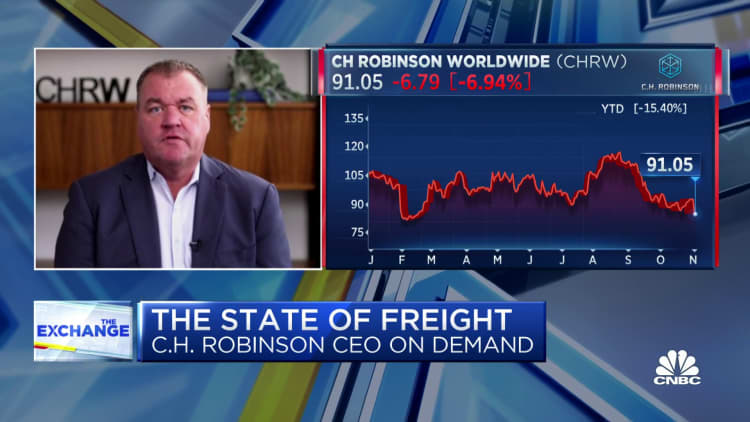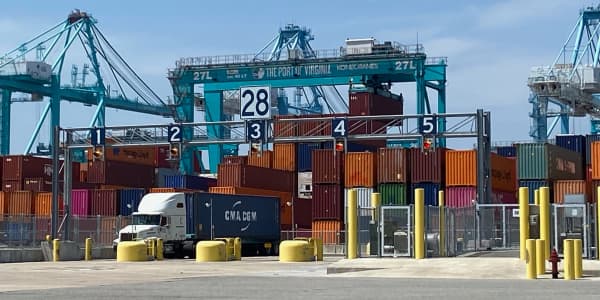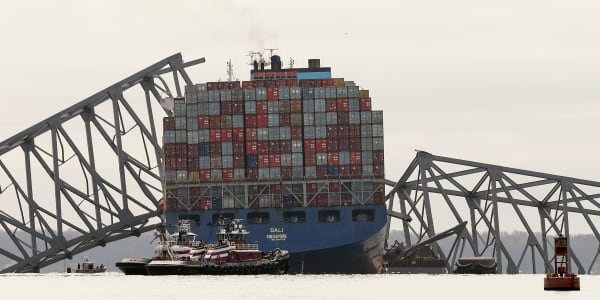An increase in blanked, or canceled sailings, from Asia bound for the U.S. is hitting some of the biggest domestic ports hard, including the Port of Long Beach and Port of Savannah, reducing their ability to ship exports. The decline in vessels coming from Asia on the Transpacific route is creating an increase in the wait time, or dwell time, of export containers at the Port of Long Beach.
Supply chain research firm Project44 tracks exports from "gate-in to loaded on a ship," said Joshua Brazil, Project44 vice president of supply chain insights, and that metric hit 18.33 days at the Port of Long Beach, as of November 10.
"We are projecting 28 blank sailings for Q4, which represents approximately 15% of our quarterly vessel capacity," said Mario Cordero, executive director of the Port of Long Beach. "As shipping lines reduce their vessel calls in the form of blank sailings, this reduces the capacity for outbound volumes. That said, we continue to prioritize exports over empties, which is one reason empties are ticking up on terminal."
Cordero said that the port anticipates loaded imports to continue to taper off for the rest of the calendar year.
Carriers 'take out' capacity as shipping rates crater
Ocean carriers have been increasing the number of canceled sailings in an effort to address the drop in ocean orders as well as to put a floor in ocean freight prices that have been tumbling.
Shipping firm HLS wrote in a note to customers, "More and more carriers have agreed on the strategy to "take out capacity to meet demand", although no one wants to be the first to suspend a service, which potentially loses market share."
HLS warned of more "radical" capacity reductions from THE Alliance (the ocean alliance of Hapag-Lloyd, Yang Ming, and ONE), pointing out that 2M Alliance (comprised of Maersk Line and MSC) has already suspended one-third of its West Coast services. Blank sailing and service suspension to the U.S. East Coast is also expected to increase.
Sea-Intelligence wrote in its recent blank sailings report that it has detected some unannounced cancellations for the calendar-year period of weeks 42-52 in the past two weeks.
"Blank sailings have been ramped up drastically on the Transpacific, but not so much on Asia-Europe," said Alan Murphy, CEO at Sea-Intelligence.
There have been 34 additional blank sailings on Asia-North America West Coast, and 16 on Asia-North America East Coast, according to its data, with carriers announcing an additional seven to 11 blank sailings in all but five weeks of the analyzed period through the end of the year, he said.
But as of now, for weeks 51 and 52, carriers have scheduled no blank sailings on the Asia-North America West Coast route, which Murphy says is a reflection of the carriers' indecision as to how to approach the potential pre-Chinese New Year rush.
"It appears more to be a wait-and-see approach, in terms of whether there will be a seasonal demand spike," he added.
On Asia-North Europe routes, Sea-Intelligence is only seeing an additional six blank sailings, and on Asia-Mediterranean routes an increase of four blank sailings.
End of a record run for U.S. import container volumes
"The blank sailings reflect the softening in the market and the reaction by ocean carriers to consolidate or cancel voyages to account for changing market conditions," Cordero said. "Following a record run that lifted us to record years, we projected this earlier this year. ... Things are beginning to taper off," he said. "The good news is that operations are returning to normal and the Port of Long Beach is ready to handle container volume growth," he added.
From January through October 2022, the port's container volumes are 1.5% ahead of the same period last year. However, loaded imports are essentially flat. After peaking at 436,977 twenty-foot equivalent units (TEUs) in May, monthly loaded imports went on a downward trend starting in June. On Thursday, Cordero offered the port's October update, with the dockworkers and terminal operators moving 658,428 TEUs of cargo containers last month. That was a 16.6% decline year over year, with imports down 23.7% to 293,924 TEUs, and exports also decreasing 2% to 119,763 TEUs. The port also saw a 13.4% decrease in empty containers moved through the Port to 244,743 TEUs.
With fewer vessels calling the port, Cordero said that has enabled the port stakeholders to move out the backlog of import containers that have been on the terminal for nine-plus days. Accounting for 4% of all containers, the number of long-dwelling containers is now lowest since the port started tracking the containers in October 2021. But containers waiting to leave the port by rail remain an issue, down from 14 days two weeks ago to a still high nine days.
Rails are caught up in ocean issues
The rails are experiencing growing pains as a result of low ocean chassis availability at both the Oakland and East Coast rail ramp, especially to the smaller interior markets.
"The major contributing factor is the lack of distribution centers and warehouses receiving capacity throughout the U.S. and ocean container dwell time awaiting unload," said Paul Brashier, vice president of drayage and intermodal at ITS Logistics. "Oakland chassis should be normalized throughout November as many chassis providers are repositioning chassis from an oversaturated LA/LB market. Slowdowns and disruptions already experienced at the Port of Oakland have caused increased volume at the ports on the East and Gulf Coasts."
East Coast and Gulf port congestion
The push of trade to the East Coast and Gulf continues with the increase of vessels waiting off of select ports.
According to MarineTraffic, the Port of Savannah continues to see the largest number of ships waiting off port limits at 30, waiting for an average 5.7 days to get into port. The height of vessels waiting off the port was more than 40 in July. In September, Georgia Ports Authority (GPA) executive director Griff Lynch said it was beginning to see signs of a correction in the market.
MarineTraffic is now seeing a decrease in arriving vessels. "While port congestion in Savannah remains high, since November 7 we are seeing a reduction in the number of vessels served," said Alex Charvalias, MarineTraffic's supply chain in-transit visibility lead.
Export dwell times at the Port of Savannah have shown some recent improvement, according to port metrics. The average of an export container is approximately 6.82 days, down from 8.34 days in the second week of October and 7.35 days on November 1.
In the Gulf, the Port of Houston is starting its own long-dwell container fee next month to free up terminal space for incoming containers. The port has been a beneficiary of the diversion of West Coast trade. MarineTraffic posted on LinkedIn a chart showing the number of vessels waiting off the Port of Houston. The weekly average of vessels waiting this week is 14, waiting for an average of 6.3 days.
The CNBC Supply Chain Heat Map data providers are artificial intelligence and predictive analytics company Everstream Analytics; global freight booking platform Freightos, creator of the Freightos Baltic Dry Index; logistics provider OL USA; supply chain intelligence platform FreightWaves; supply chain platform Blume Global; third-party logistics provider Orient Star Group; global maritime analytics provider MarineTraffic; maritime visibility data company Project44; maritime transport data company MDS Transmodal UK; ocean and air freight rate benchmarking and market analytics platform Xeneta; leading provider of research and analysis Sea-Intelligence ApS; Crane Worldwide Logistics; DHL Global Forwarding; freight logistics provider Seko Logistics; Planet, provider of global, daily satellite imagery and geospatial solutions, and ITS Logistics provides port and rail drayage services in 22 coastal ports and 30 rail ramps throughout North America.






